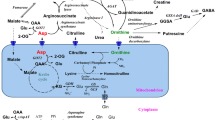Summary
The distribution of arginine and aspartic acid in brain, testes and liver was studied in rats after the simultaneous oral and intravenous administration of 0.1 mmol of these two amino acids.
Exogenous fractions were determined by incorporation of [U-14C]-arginine and [3H]-aspartic acid.
A significant increase in the free forms of the two amino acids was observed in all the organs except the liver where aspartic acid decreased after intravenous administration.
The oral route induced higher concentrations of arginine in the testes and the brain and of aspartic acid in the liver.
The concentrations of aspartic acid were higher in the brain and the testes after intravenous administration.
Up to 15 % of the dose of arginine administered was found in the liver, most of it bound to protein.
Free aspartic acid concentrations underwent two successive increases with return to baseline values between the two phases.
The first phase seemed to be due to an accumulation of the amino acid in the organ, followed by binding of the amino acid to the proteins. The second increase seemed to be due to a displacement of the protein bound form towards the free form.
The steep rise in cerebral arginine levels, peaking at 30 minutes, may be one of the determining factors governing GH secretion induced by the simultaneous oral administration of aspartic acid and arginine.
Similar content being viewed by others
References
Campistron G. (1980): Approche pharmacologique de l’arginine et de l’acide aspartique. Thèse de Sciences Pharmaceutiques (Etat), Toulouse.
Campistron G. Guiraud R, Cros J and Mosser J (1982): Pharmacokinetics of arginine and aspartic acid administered simultaneously in the rat: I Plasma kinetics, Eur. J. Drug Metab. Pharmacokin,7, 307–13.
Curtis D.R. and Watkins J.C. (1960): The excitation and depression of spiral neurons by structurally related amino acids. J. Neurochem.6, 117–41.
Blanquet P. and Laparra J. (1968): Localisation de l’aspartate d’arginine dans l’organisme lors d’administrations répétées. Sem. Hôp. (Paris),44, 646–47.
Fabier J.C. (1976): Elimination au cours de la maladie de Paget d’un peptide glutamylhydroxyproline. Thèse de Spécialité de Sciences. Toulouse.
Campistron G., Fabre J., Guiraud R., Lenet R., Cros J. and Puget A. (1979): The measurement of circulation blood volume and of the blood volume impugnating organs in rat and rabbit, using113m. In labelled transferrin. In. J. Nucl. Med. Biol.,6, (3), 167–68.
Stegink L.D. (1976): Absorption, utilization and safety of aspartic acid. J. Toxicol. Environ. Health,2, 215–42
Holt L.E. and Albanèse A.A. (1944): Observations on amino acid deficiencis in man. Trans. Assoc. Amer. Phy.,50, 143–55.
Battistin L., Grynbaum A. and Uajjha A. (1971): The uptake of various acids by the mouse brain in vivo. Brain Res.,29, 85–99.
Liebschutz J. Airoldi L., Brownstein M.J., Chiin N.G. and Wurtman R.J. (1977): Regional distribution of endogenous and parenteral glutamate, aspartate and glutamine in rat brain. Biochem. Pharmacol.,26, 443–46.
Franchimont P., Luyckx A., Campistron G. and Cros J. (1979): Effets de l’aspartate d’arginine sur la sécrétion de somatotrophine, insuline et glucagon chez le rat. Thérapie,34, 641–47.
Evans R.H. (1981): Mini reviews. Pharmacological antagonists of excitant amino acid action. Life Sci.,28, 1303–8.
Nadler J.V., Vaca K.W., White W.F., Lynch G.S. and Cotman C.W. (1976): Aspartate and glutamate as possible transmitters of excitatory hippocampal afferents. Nature,260, 538–40.
Collins G.G.S. ans Probett G.A. (1981): Aspartate and not glutamate is the likely transmitter of the rat lateral olfactory tract fibres. Brain Res.,209, 231–34.
Canzek V. and Reubi J.C. (1980): The effect of cochlear lesion on the release of glutamate, aspartate and GABA from cat cochlear nucleus in vitro. Exp. Brain Res.,38, 437–41.
Baughman R.W. and Gilbert CD. (1980): Aspartate and glutamate as possible neurotransmitters of cells in layer 6 of the visual cortex. Nature,287, 848–50.
Batrak G.E. and Varosh A.K. (1980): Changes in the reactive properties of the body under anesthesia after pretreatment with aspartic acid. Farmakol. Toksikol.,43, 277–80.
Koyuncuoglu H., Gungor M., Eroglu L. and Sagduyu H. (1979): The antagonizing effect of aspartic acid on morphine withdrawal and levallorphan-abstinence precipitated syndrome signs and on associated changes in brain levels of free amino acids in the rat. Psychopharmacol.,62, 89–95.
Koyuncuoglu H., Sagduyu H., Gungor M., Eroglu L. and Geng E. (1977): Antagonizing effect of aspartic acid on the development of physical dependence and tolerance to morphine in the rat. Arzneim. Forsch.,27, 1676–9.
Author information
Authors and Affiliations
Rights and permissions
About this article
Cite this article
Campistron, G., Guiraud, R., Cros, J. et al. Pharmacokinetics of arginine and aspartic acid administered simultaneously in the rat: II tisue distribution. European Journal of Drug Metabolism and Pharmacokinetics 7, 315–322 (1982). https://doi.org/10.1007/BF03189635
Received:
Issue Date:
DOI: https://doi.org/10.1007/BF03189635



